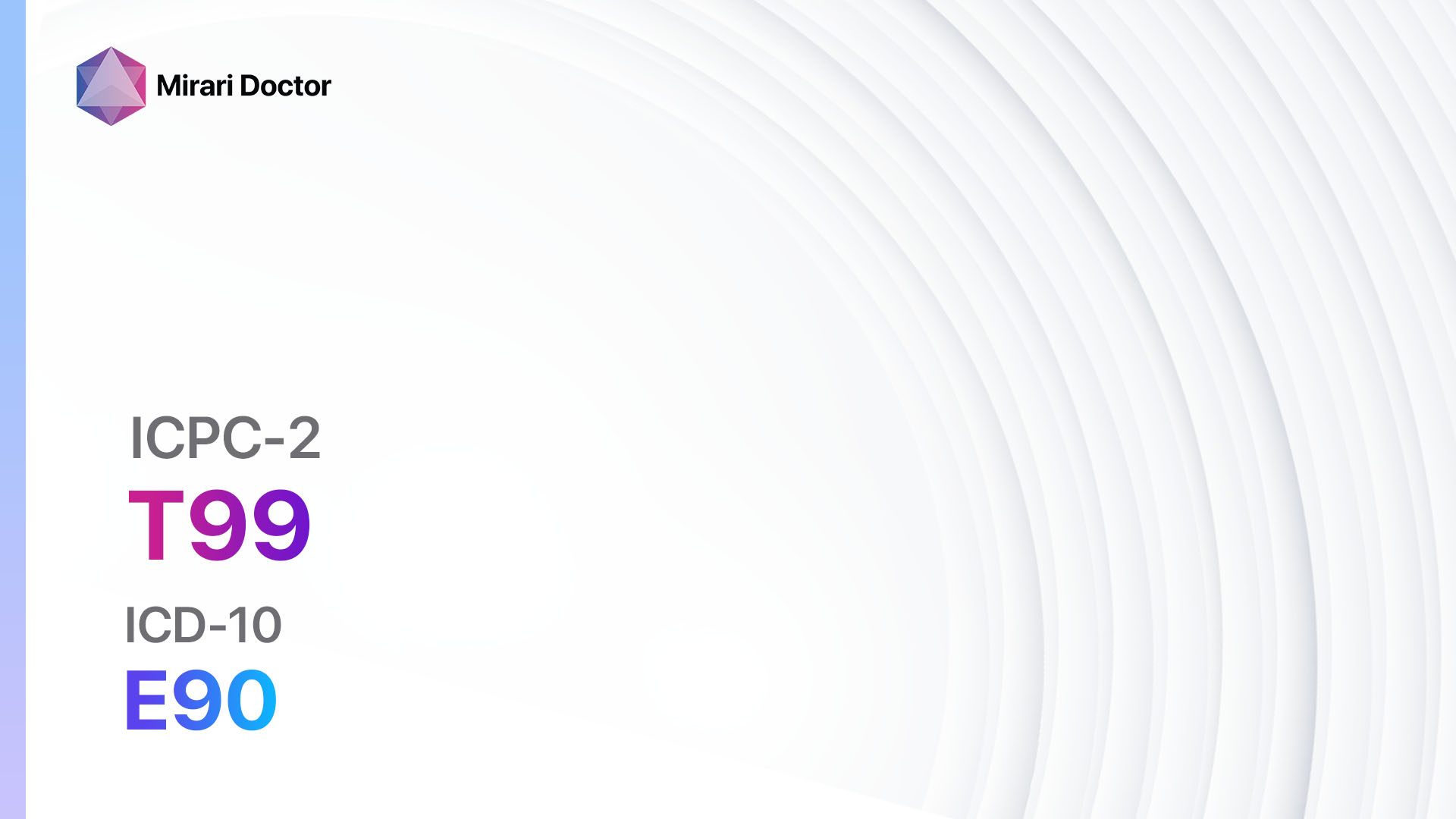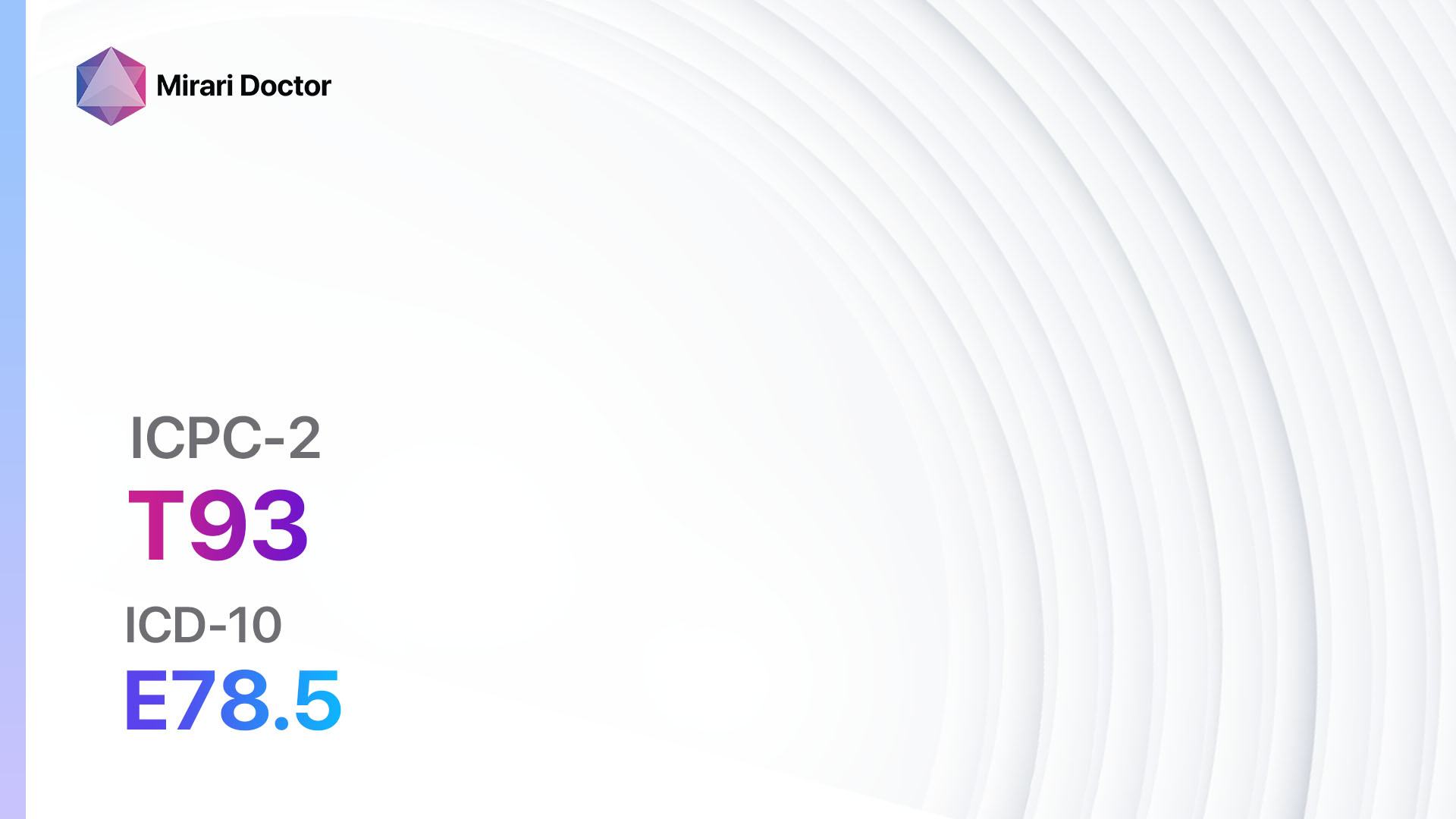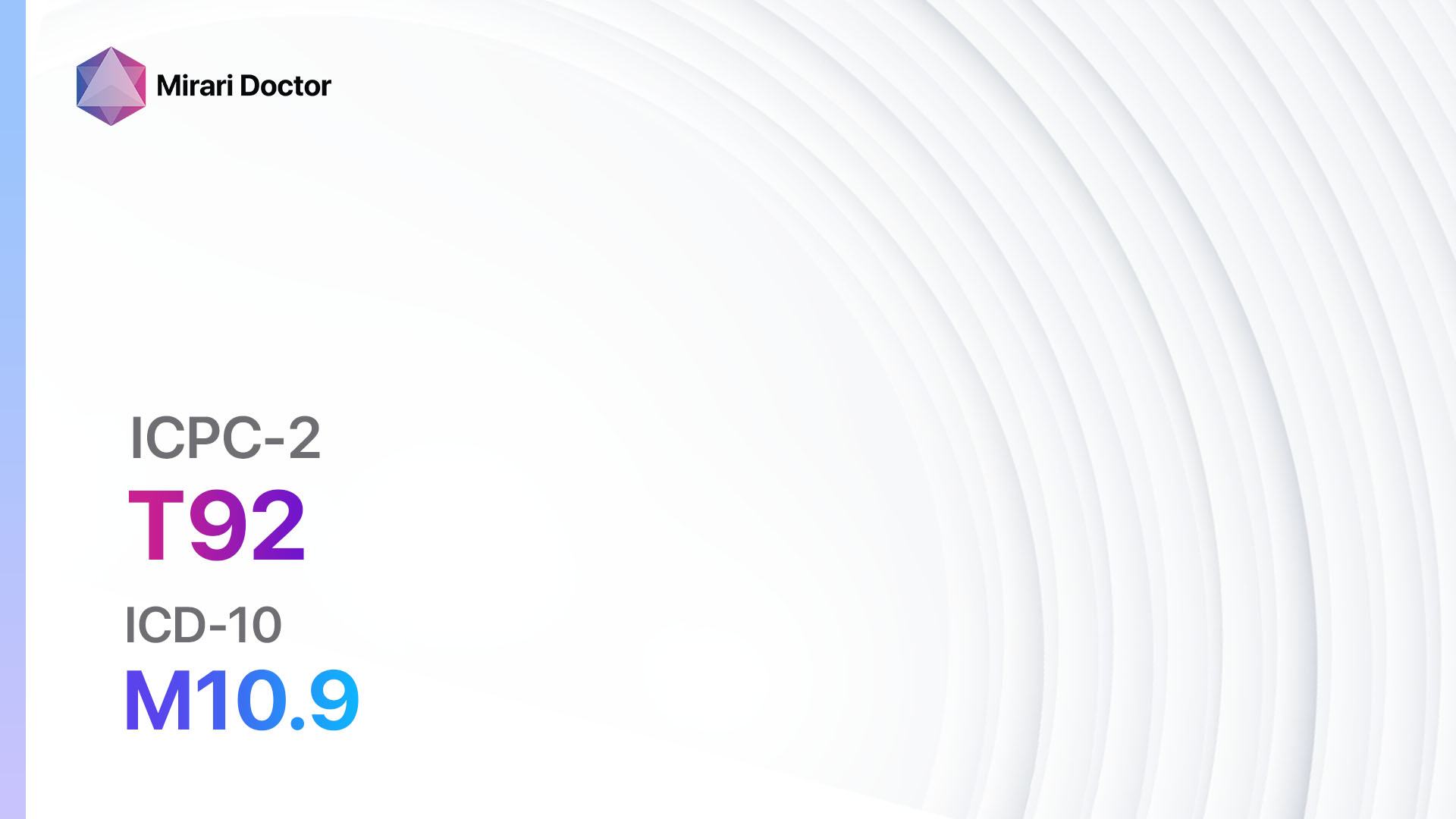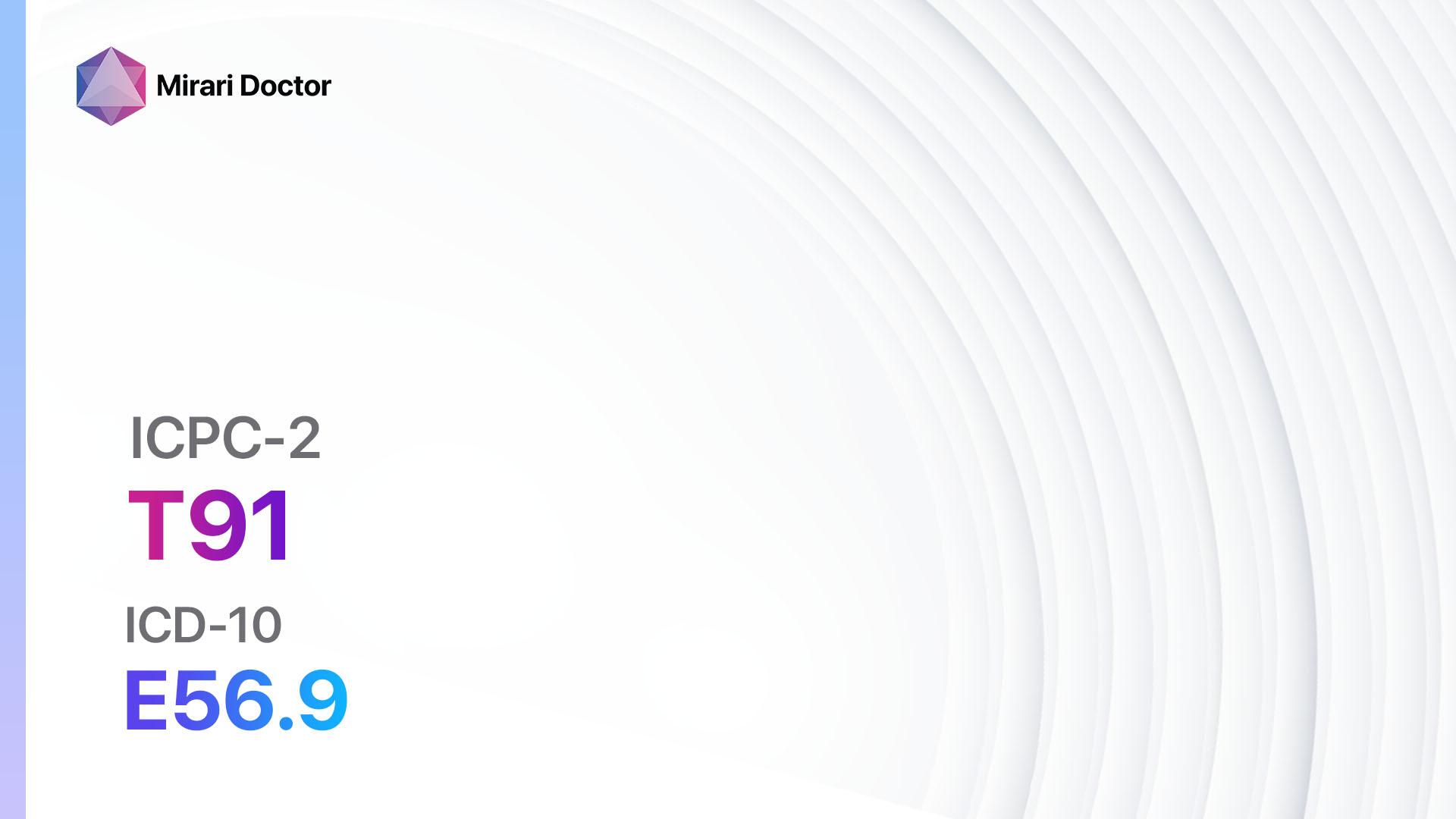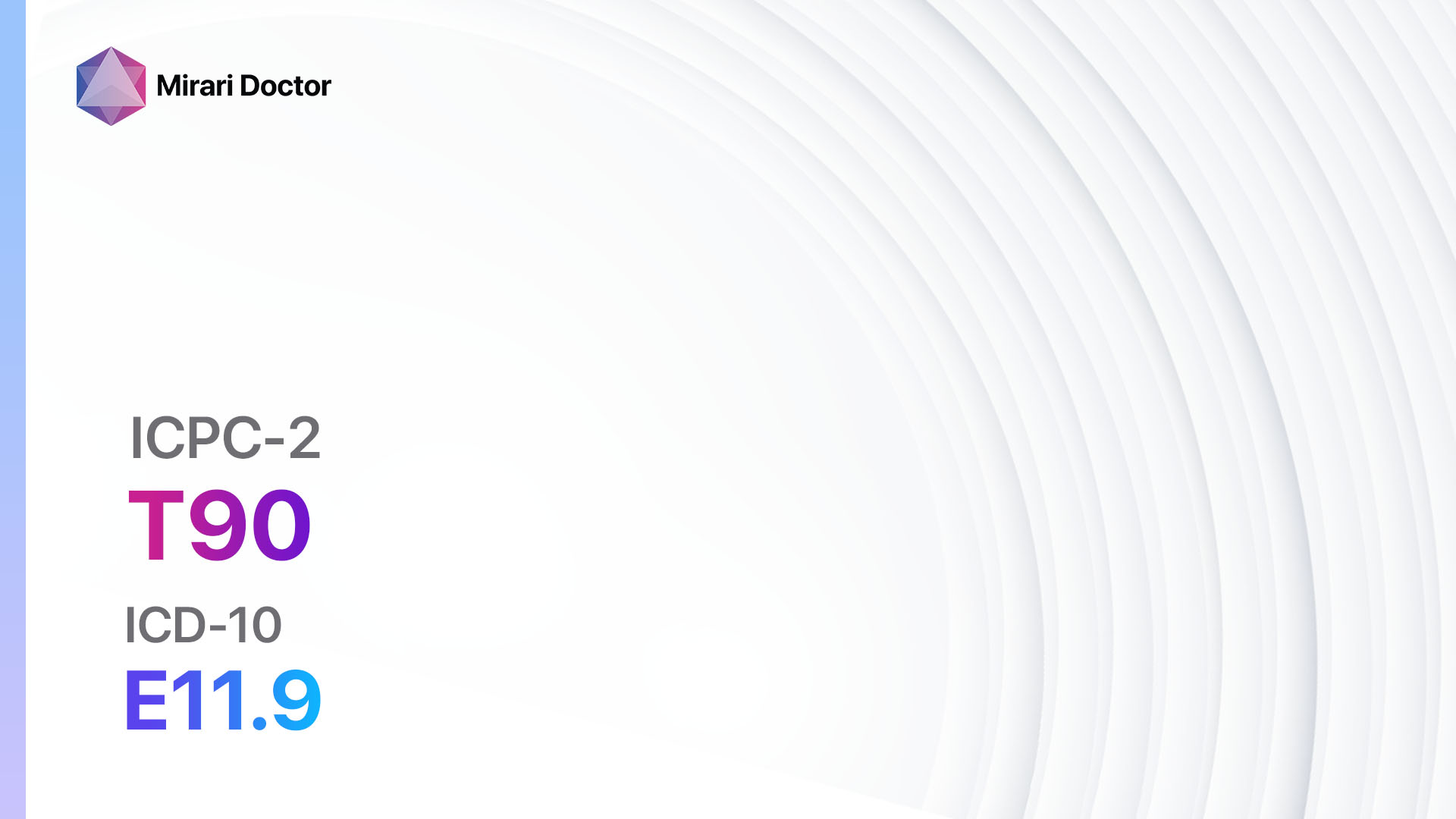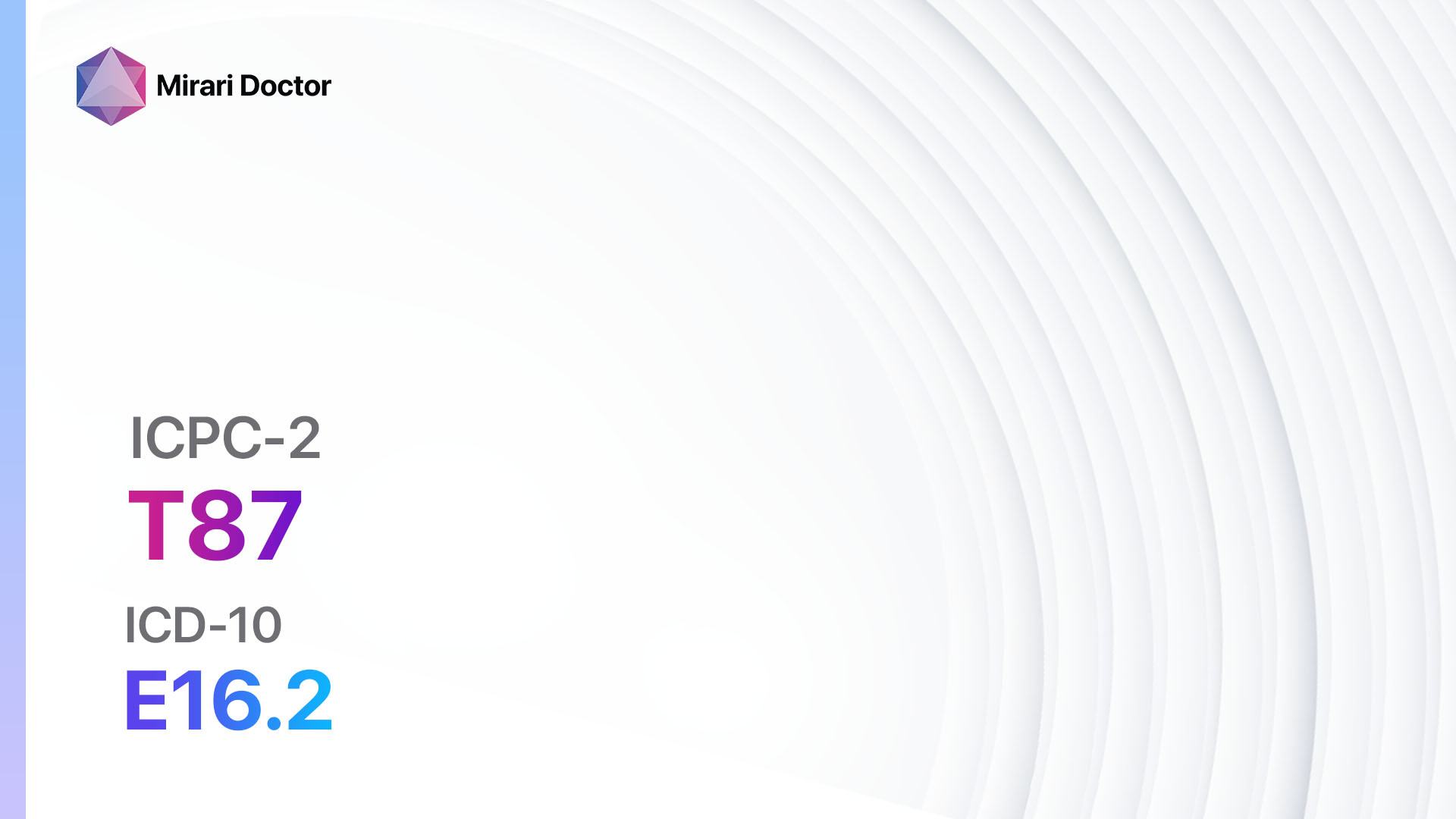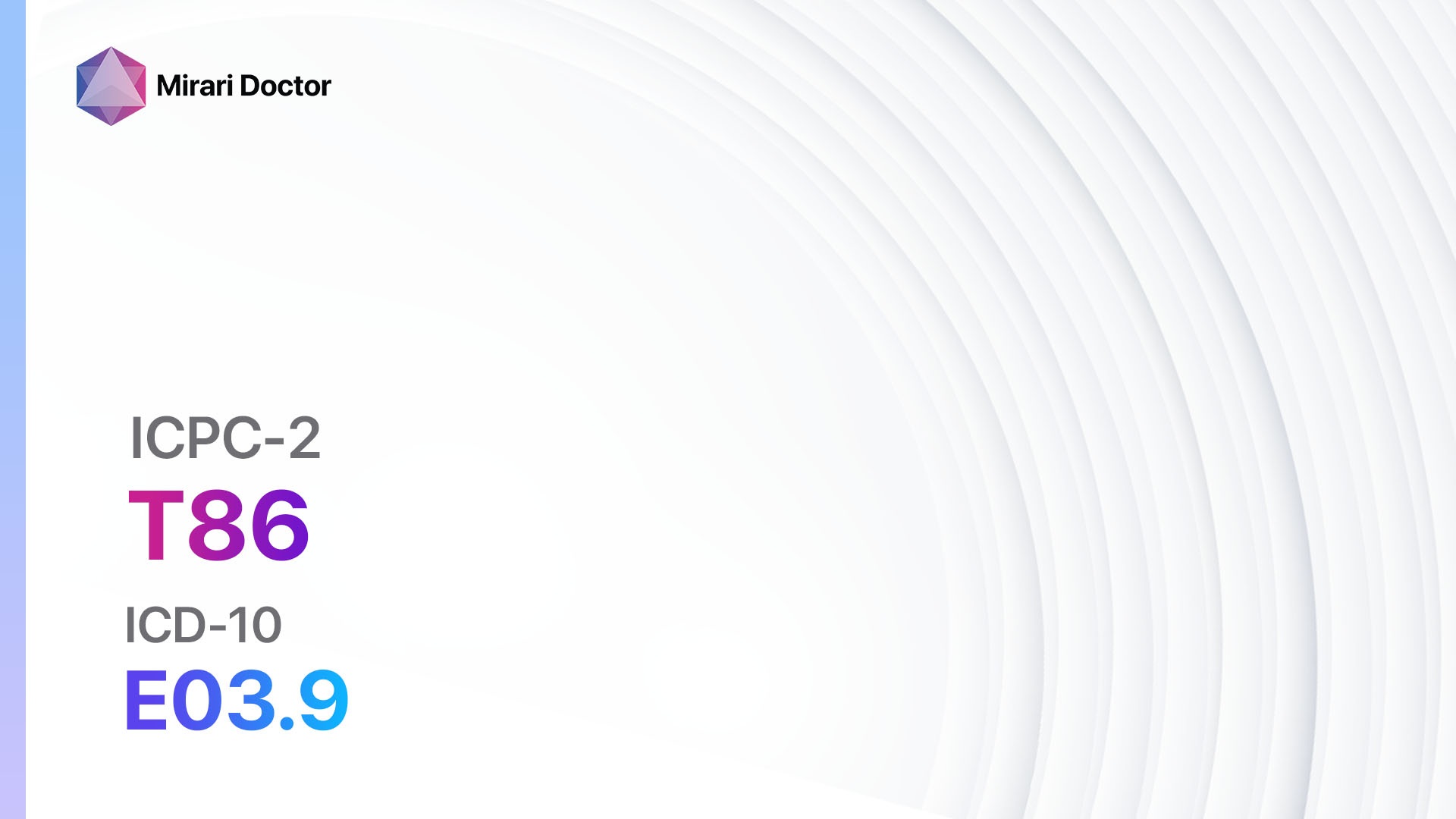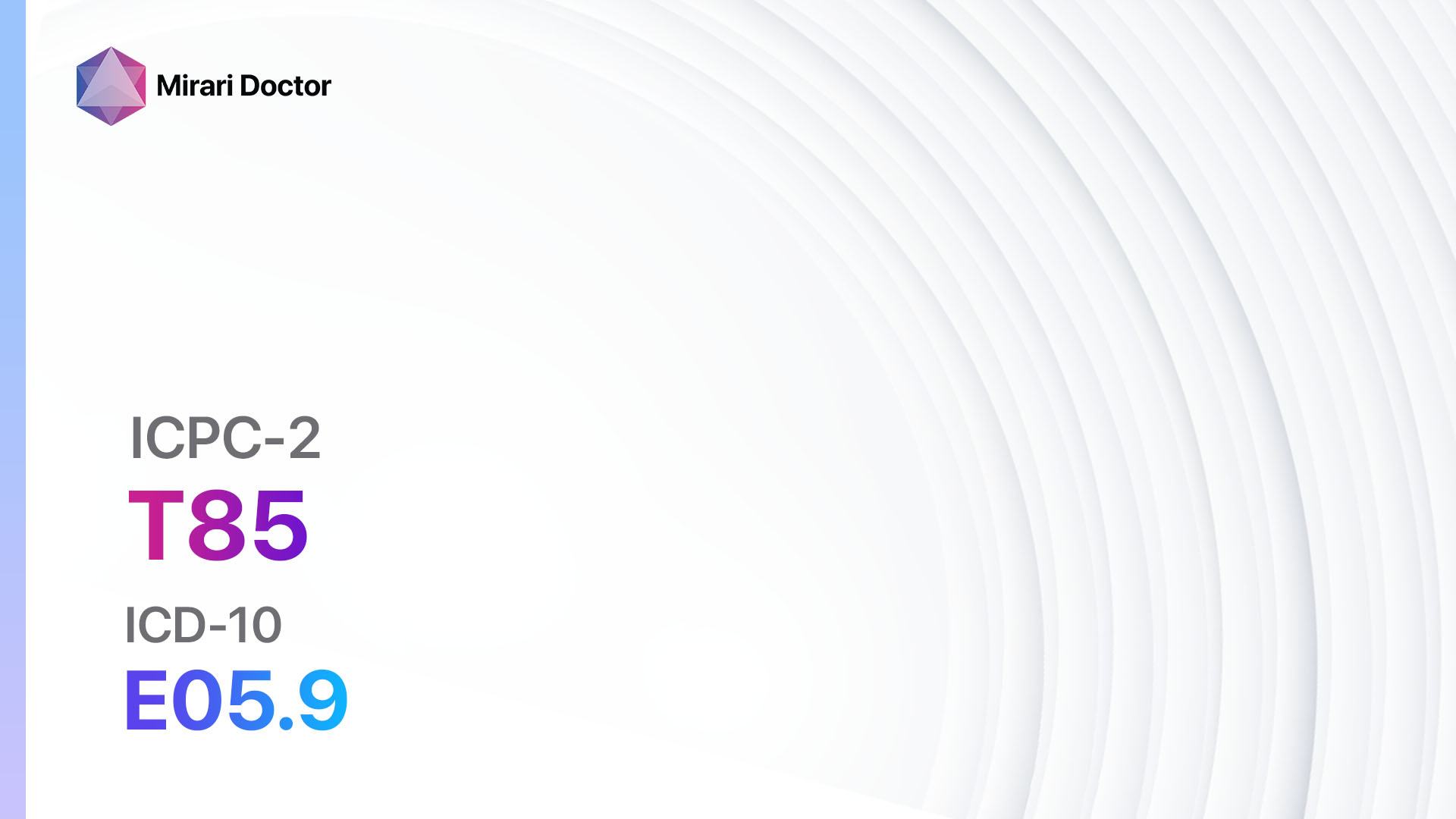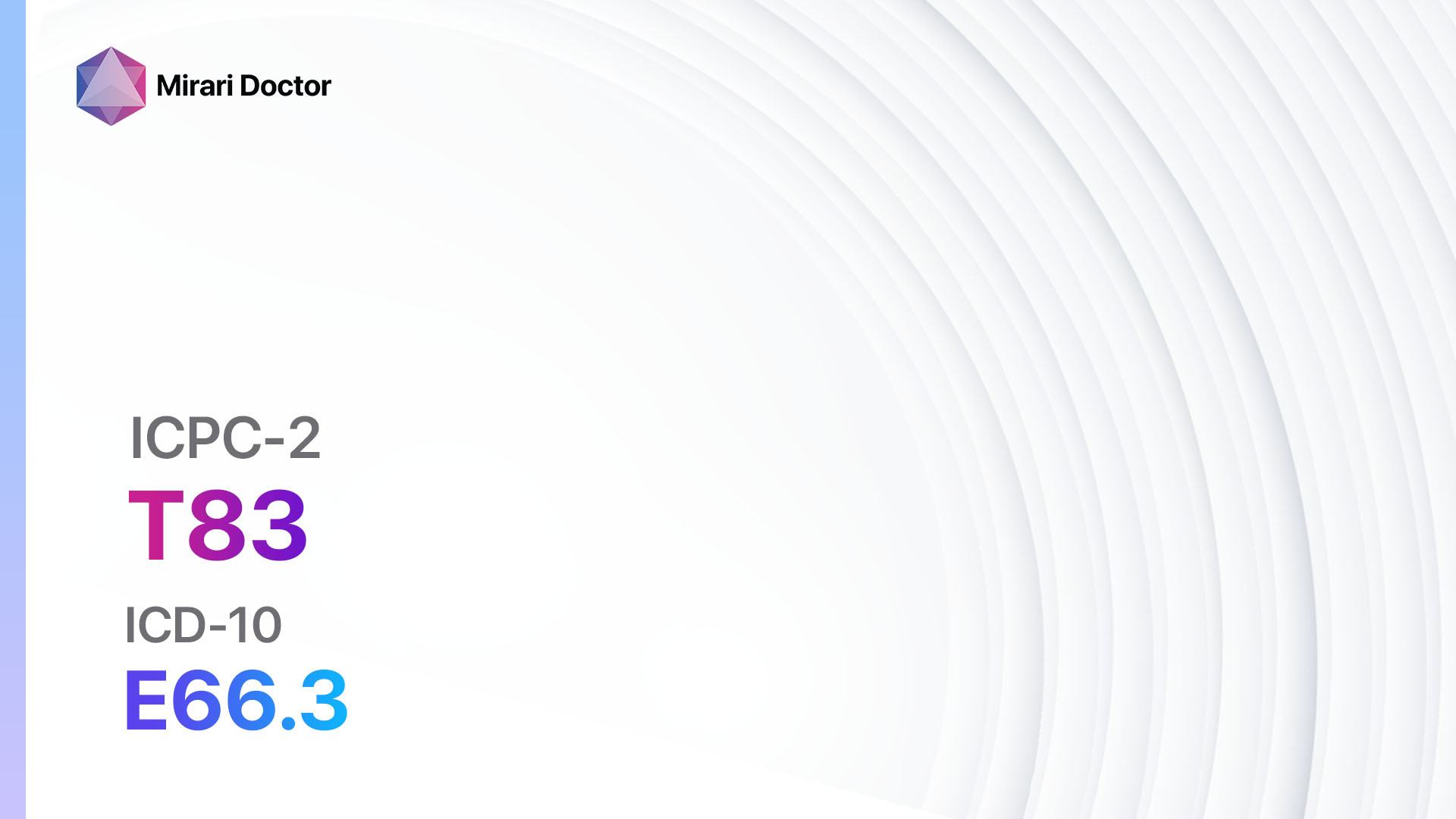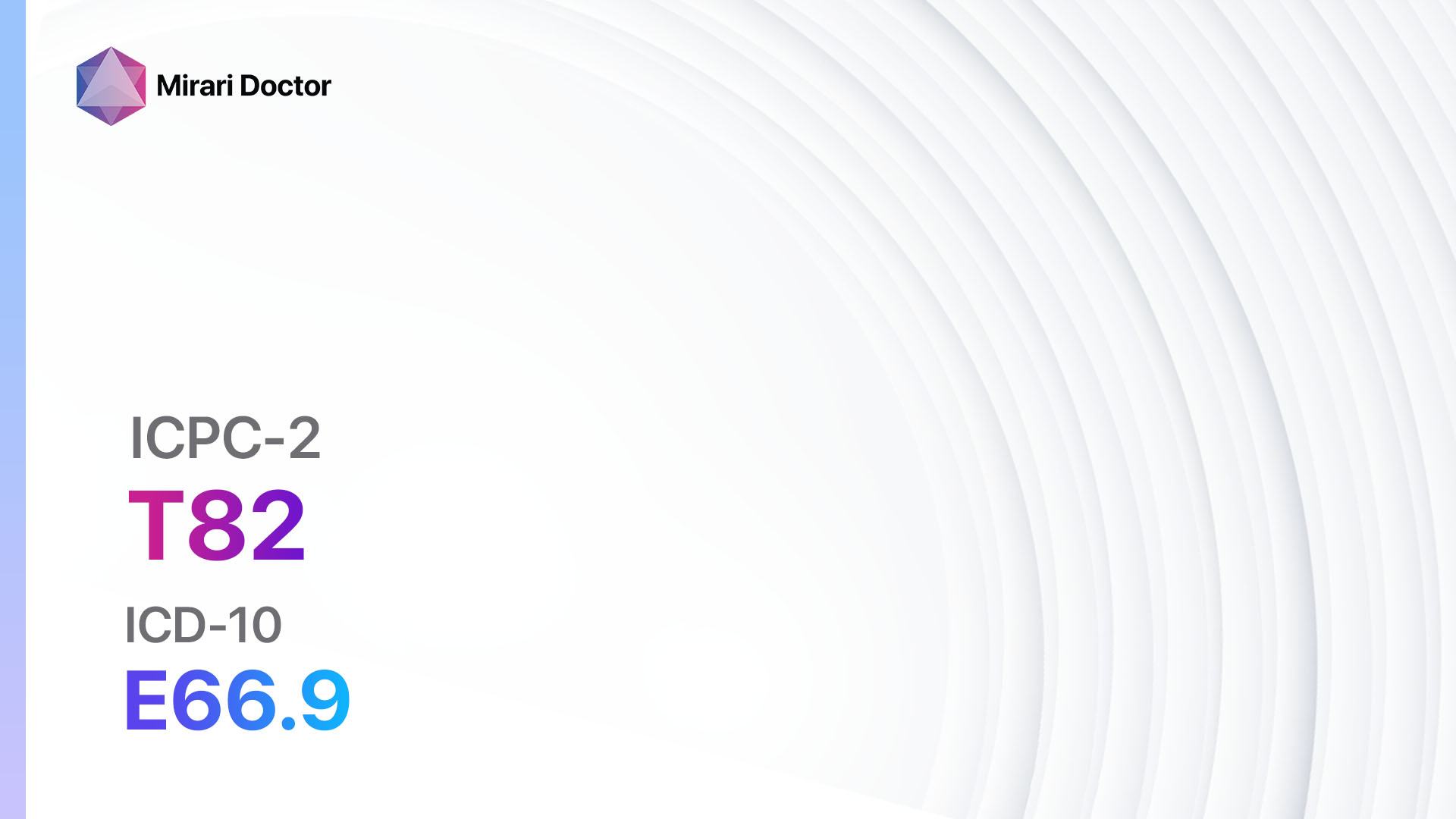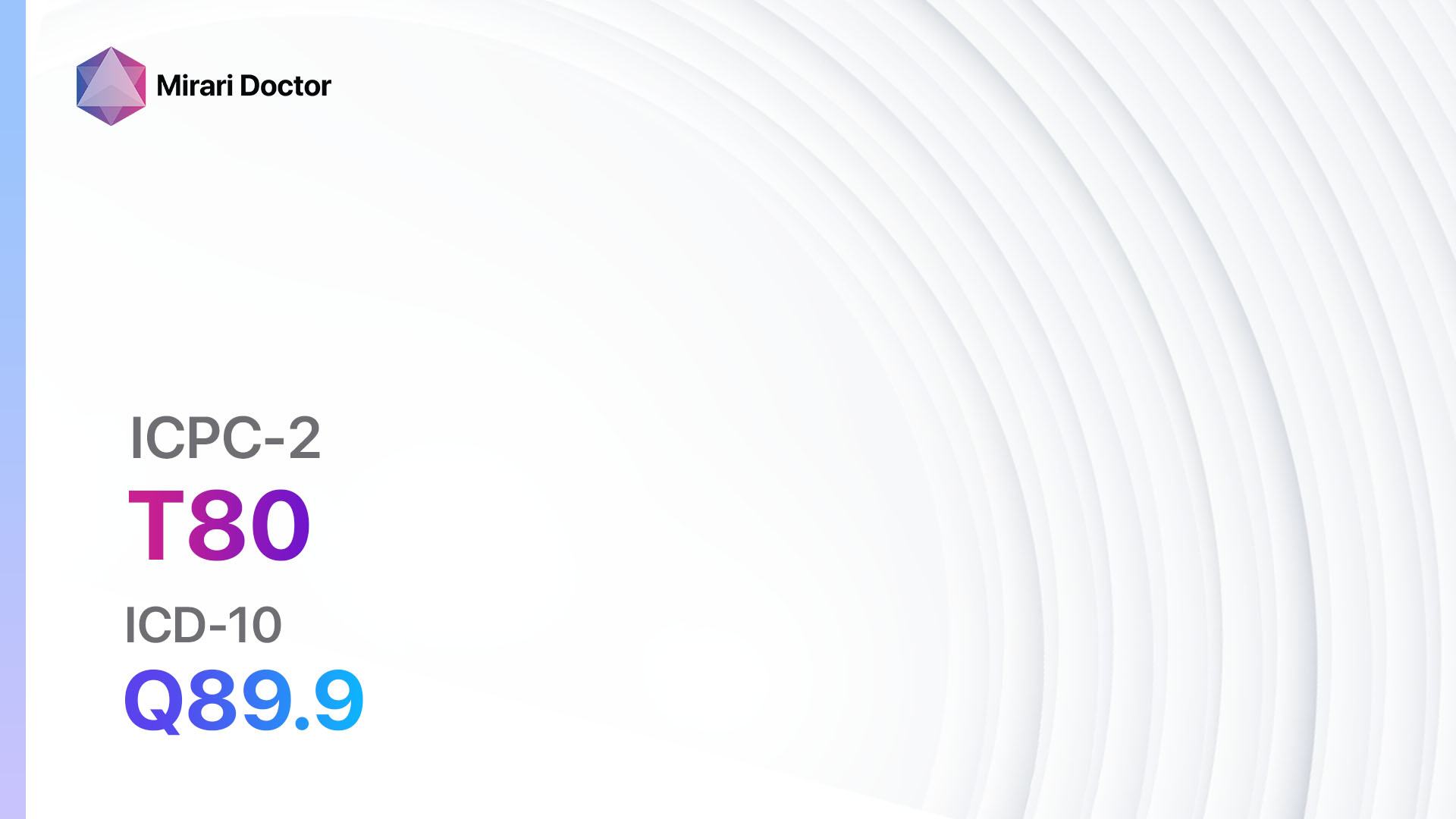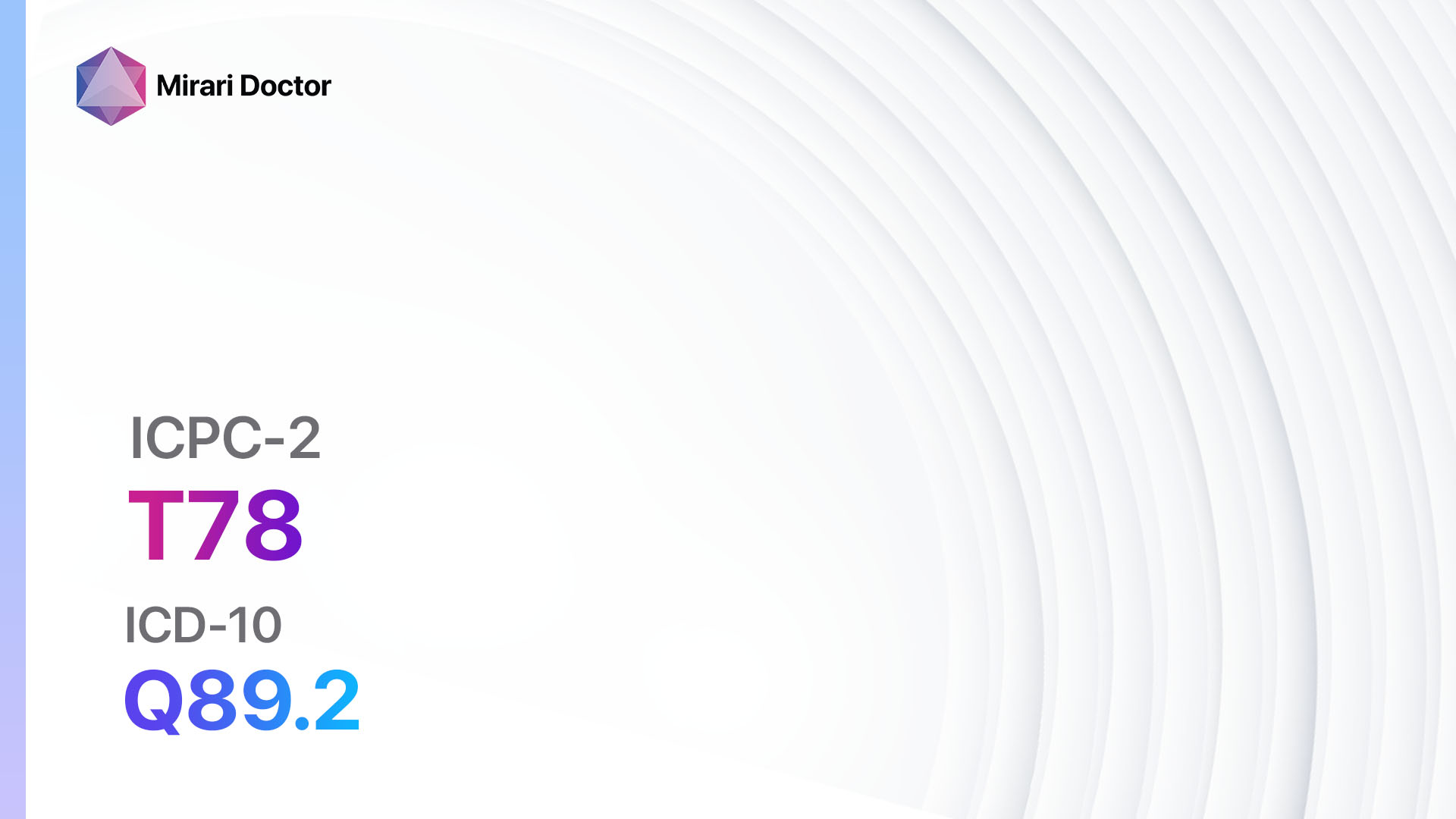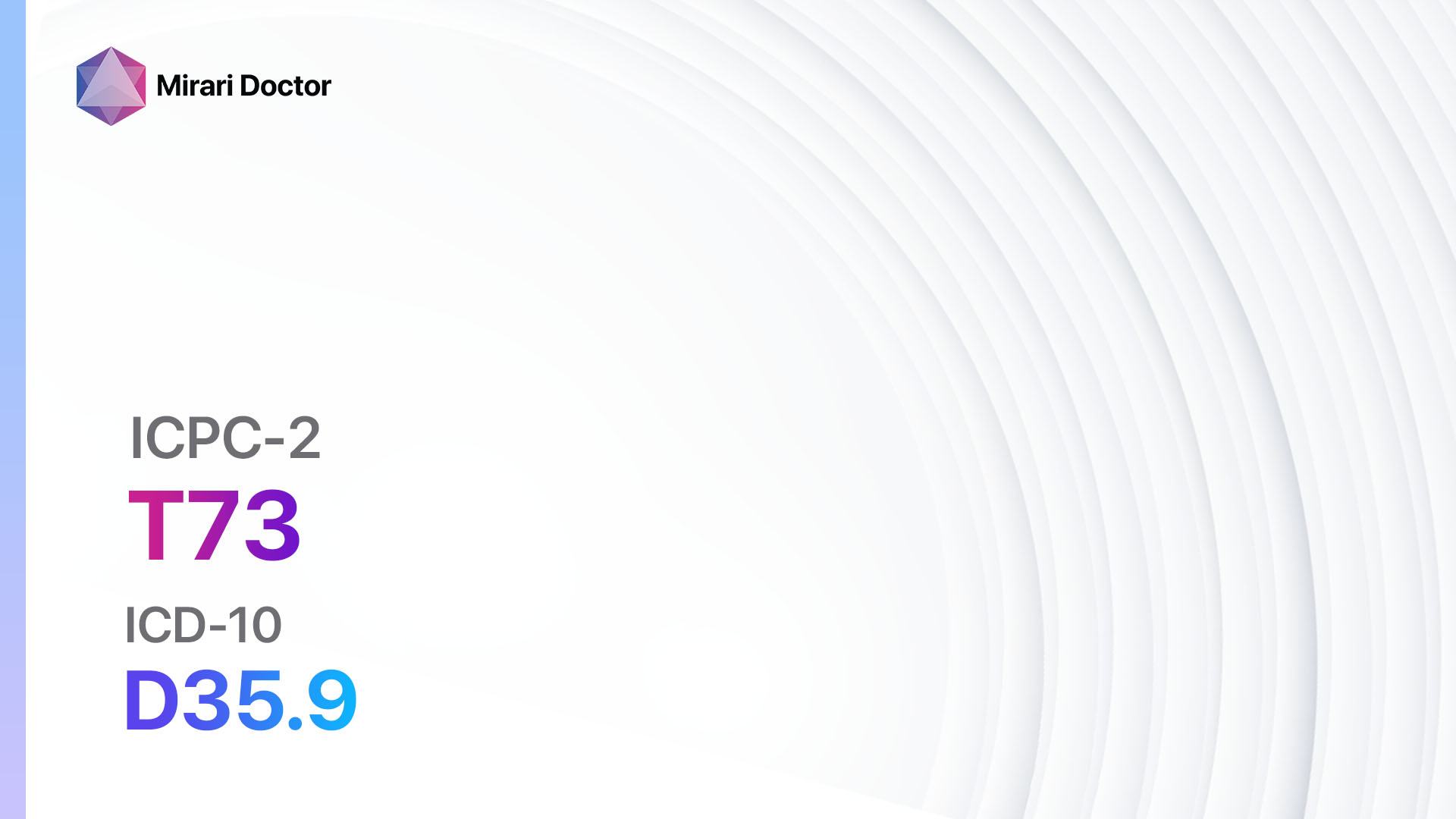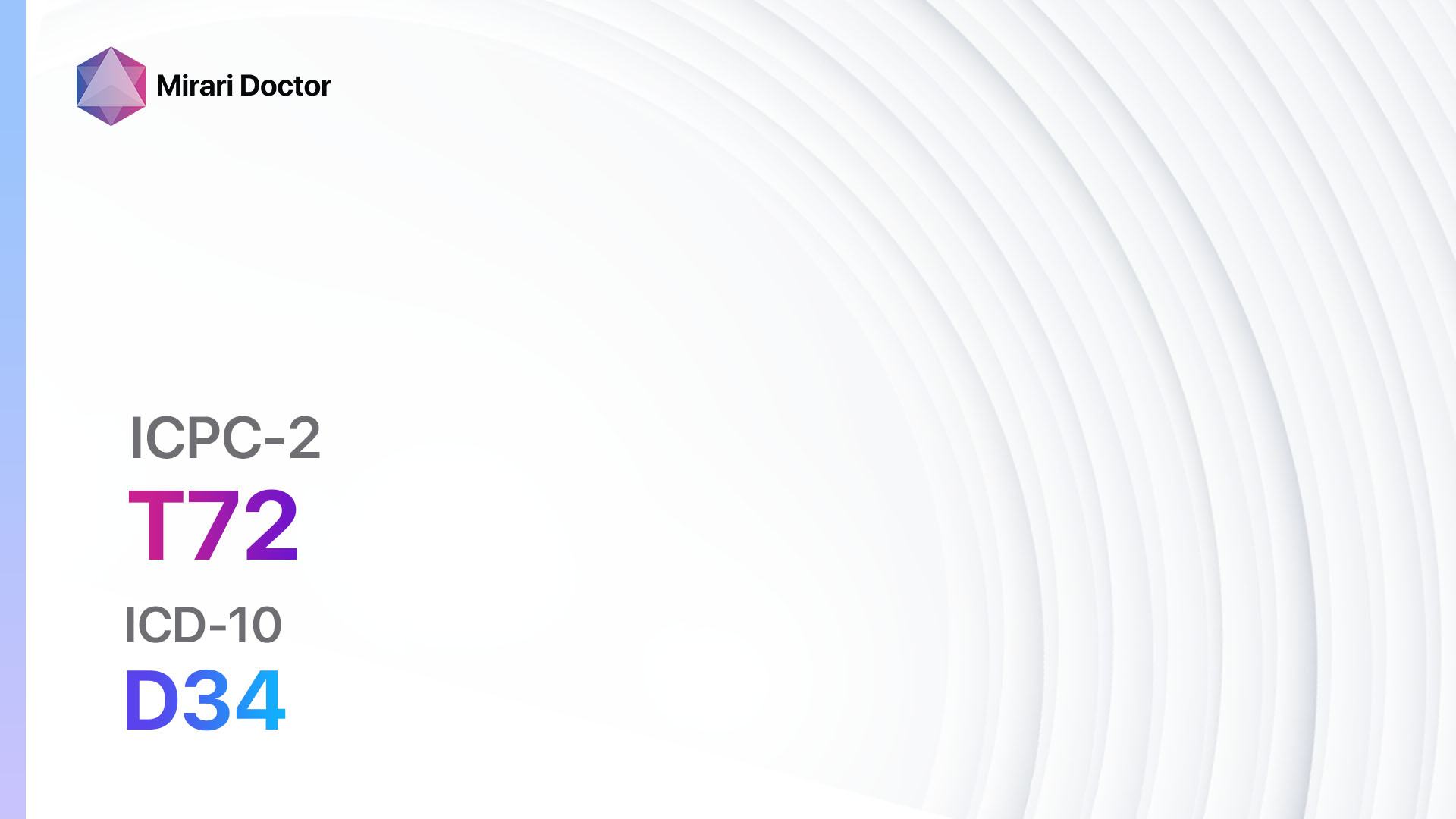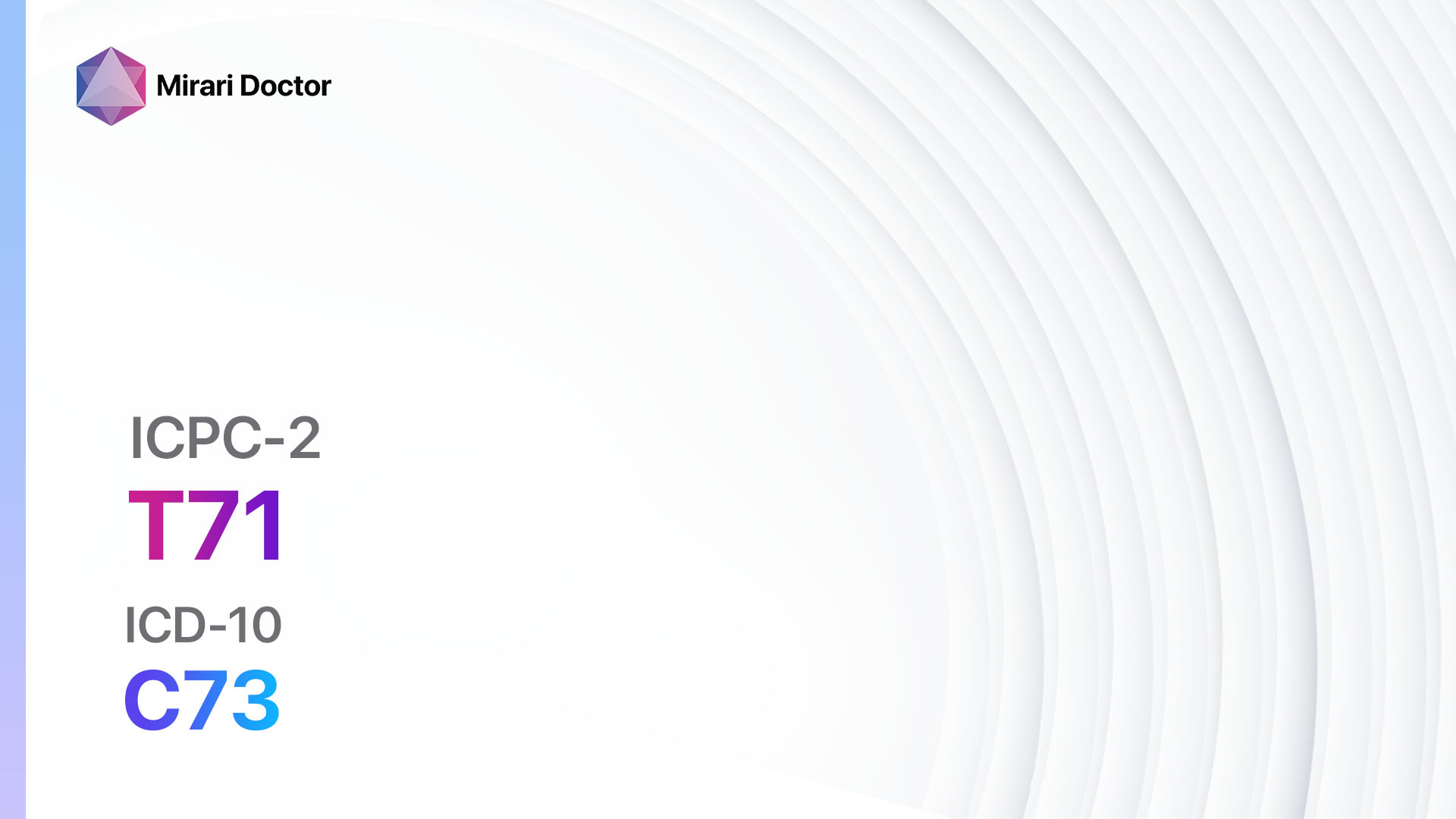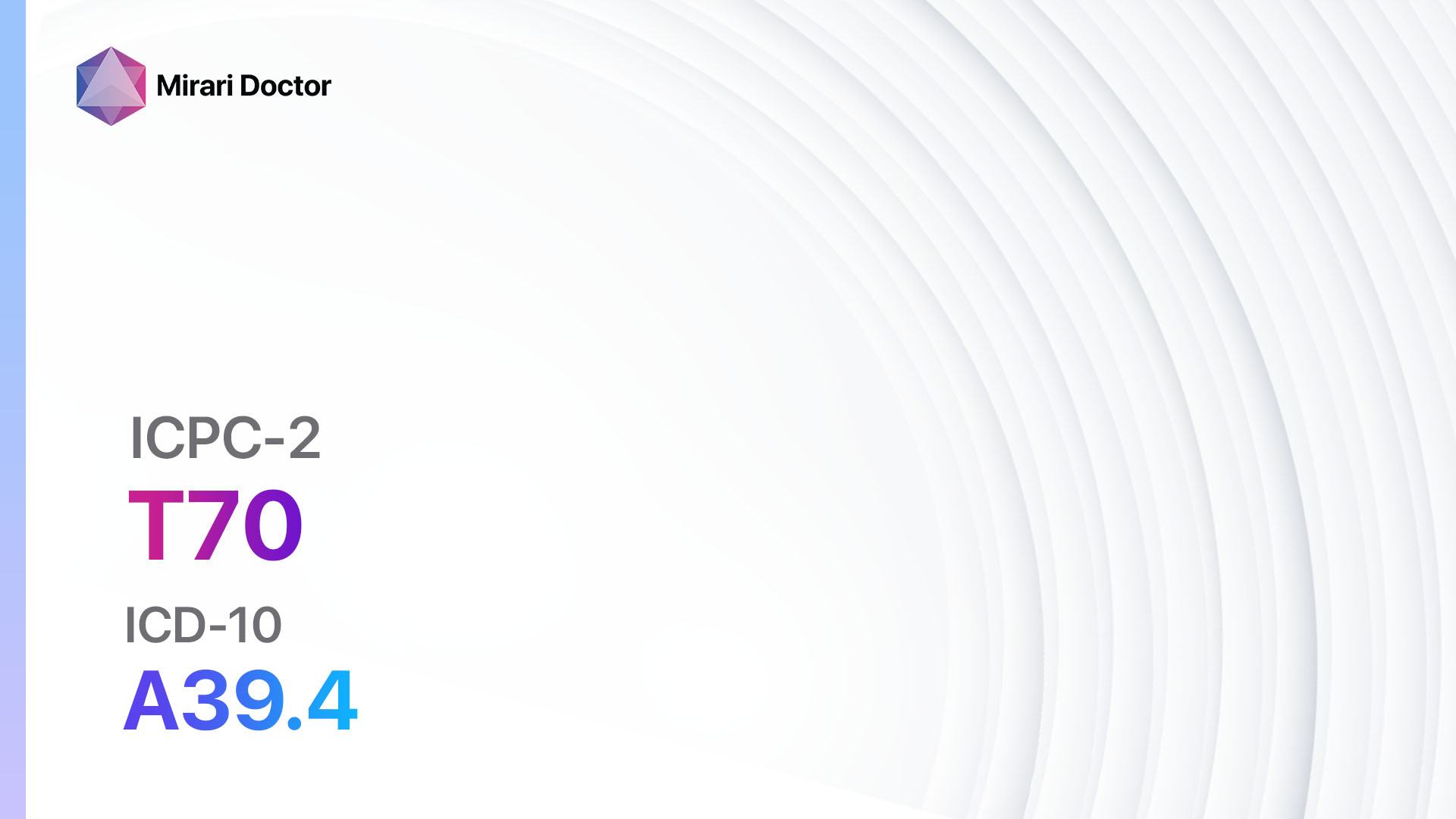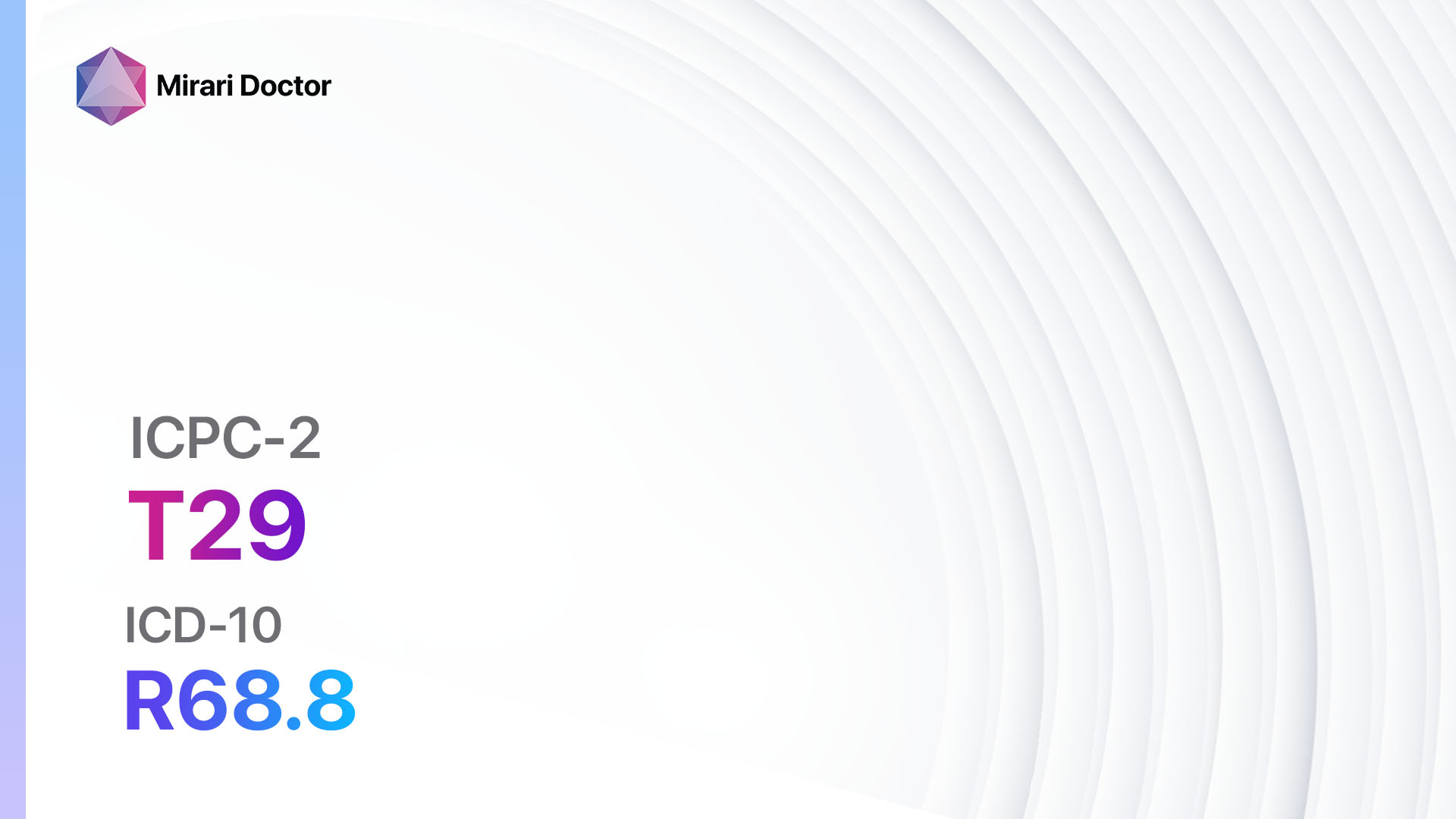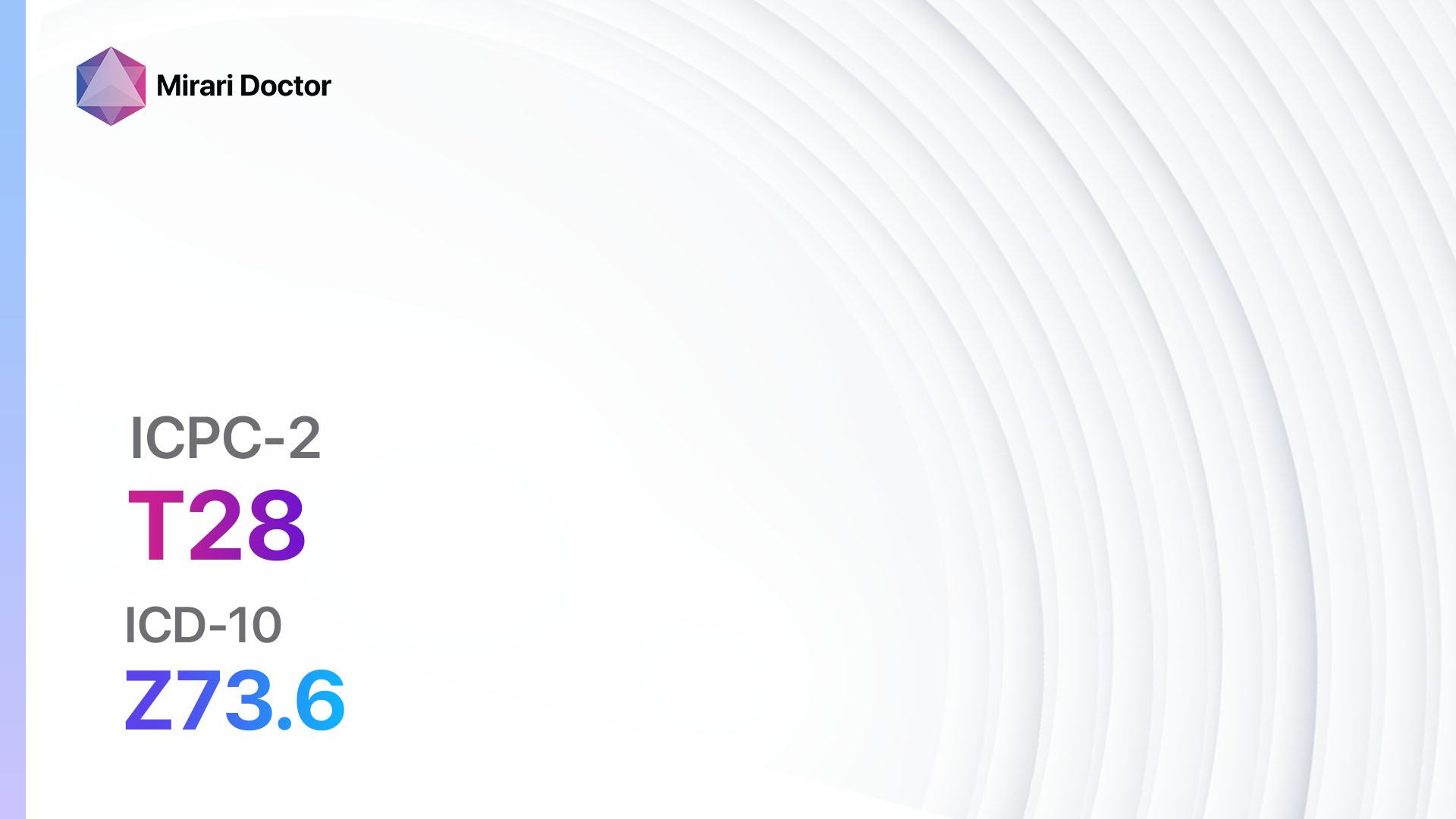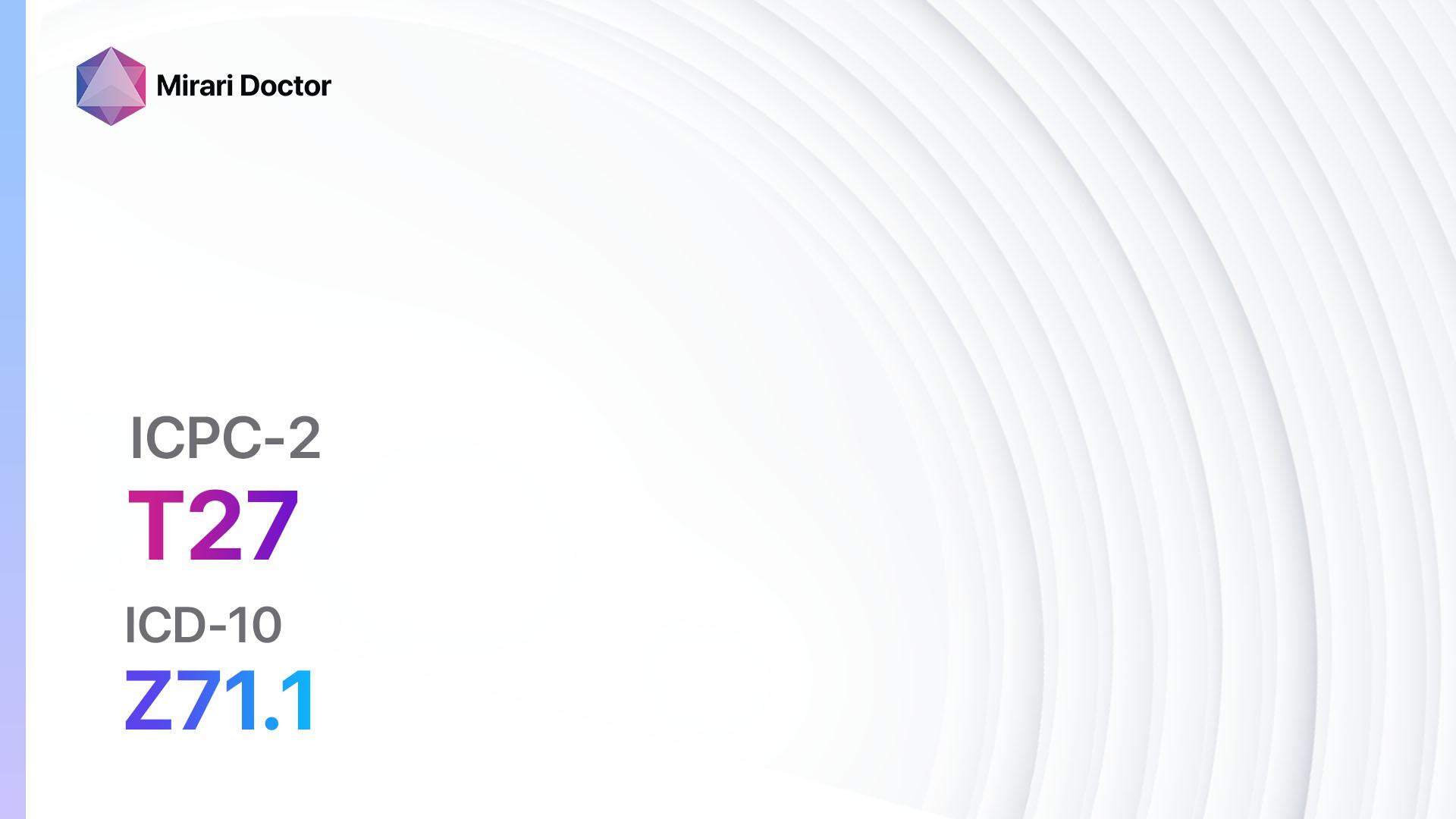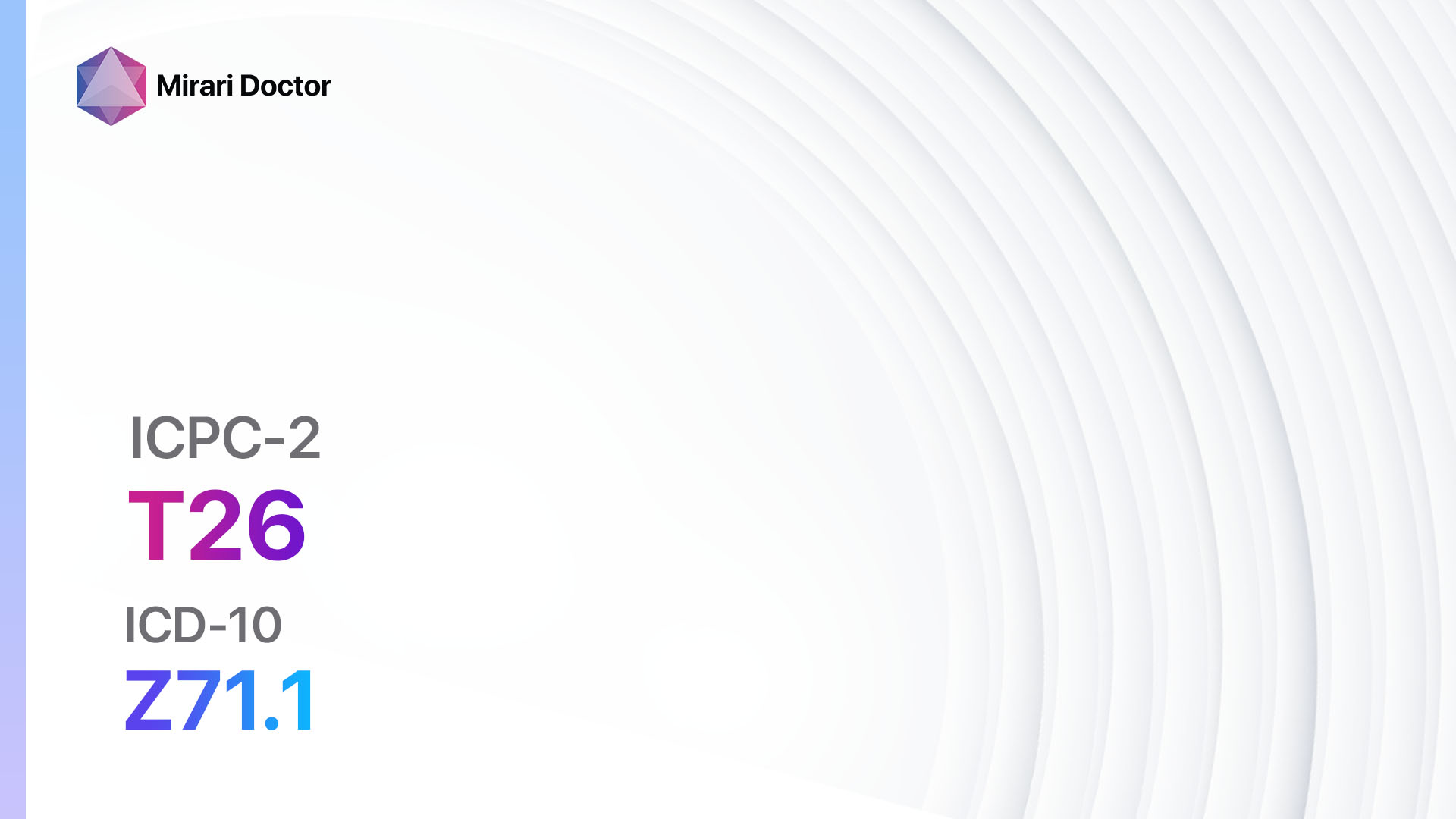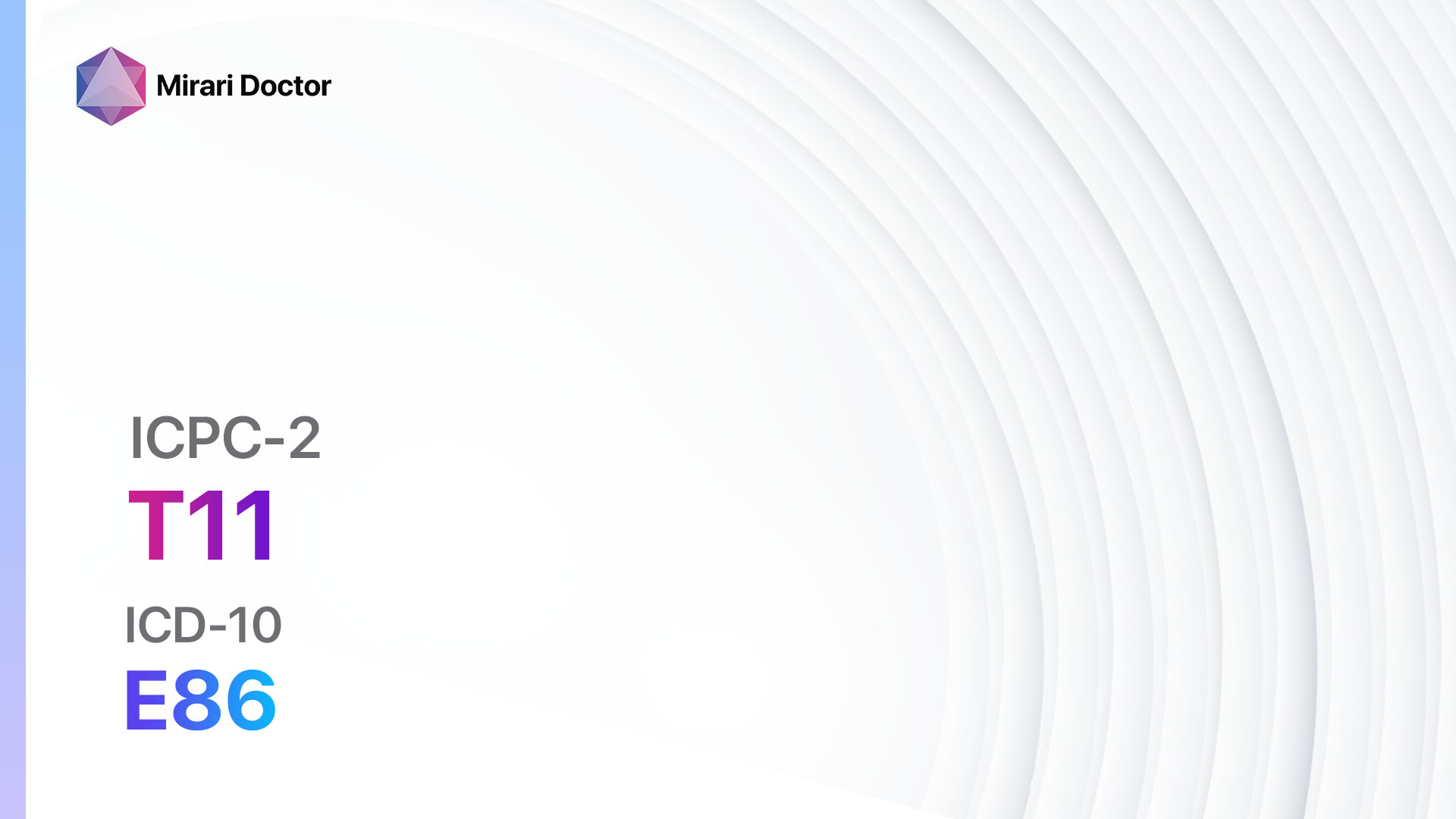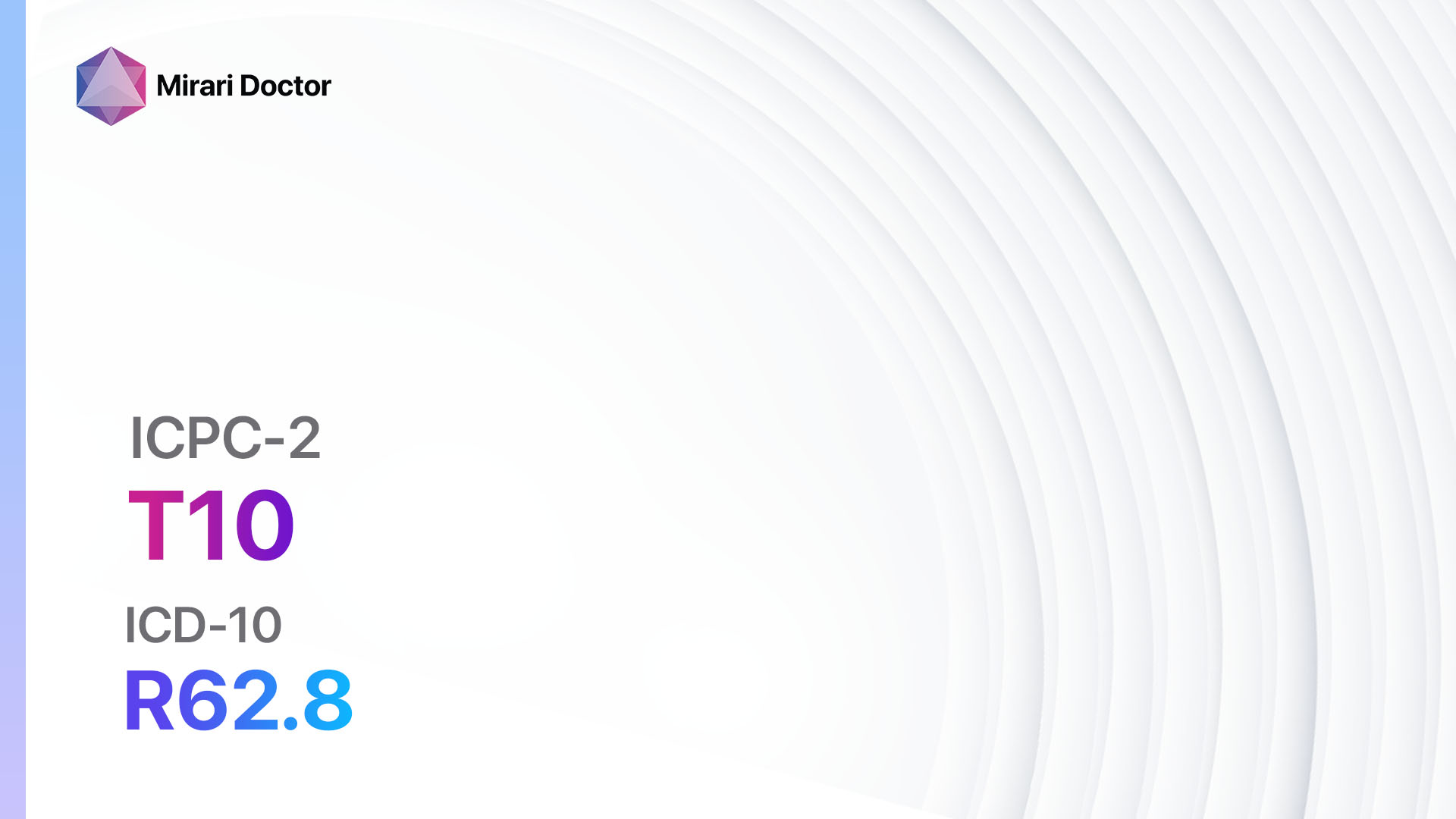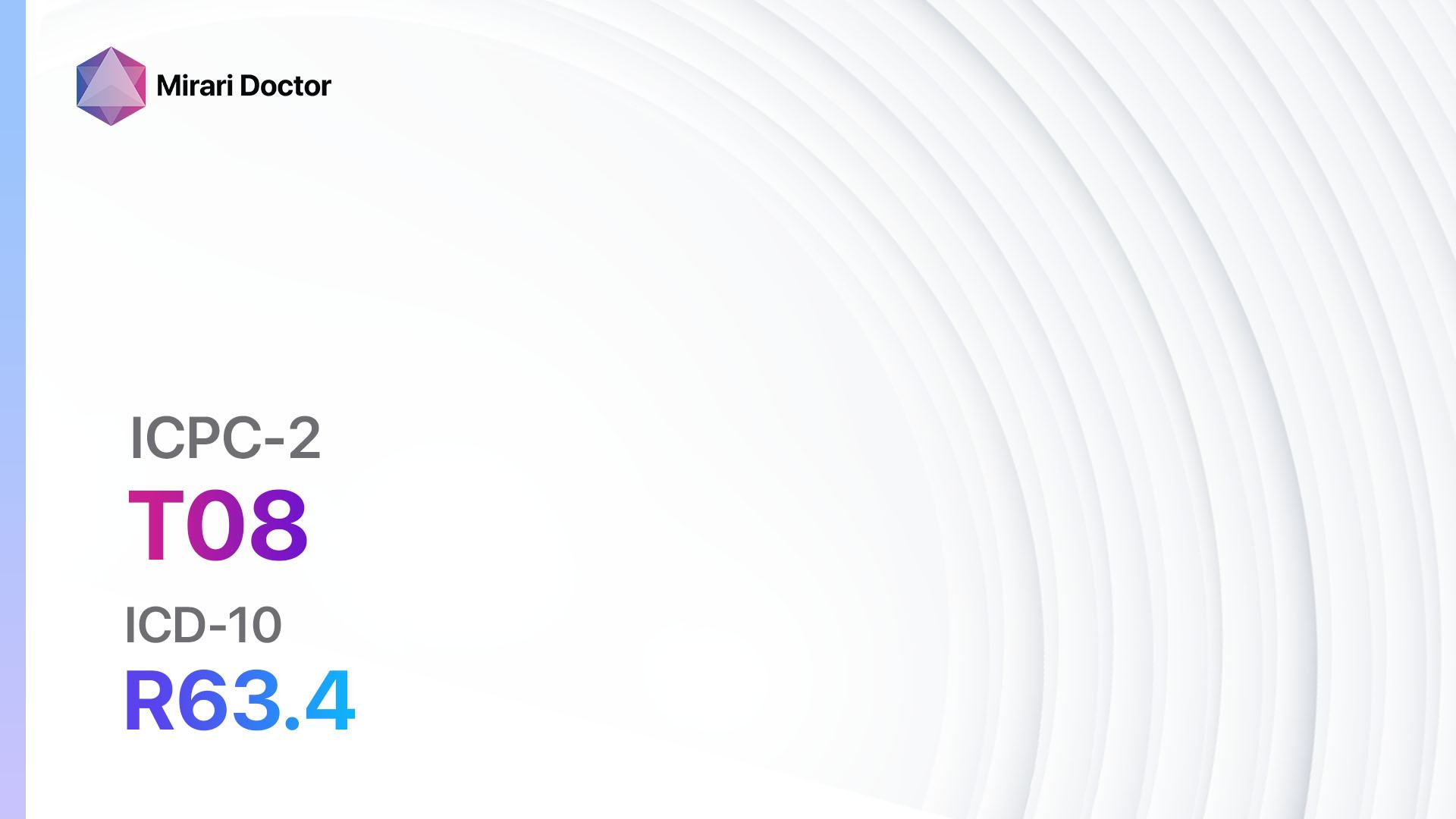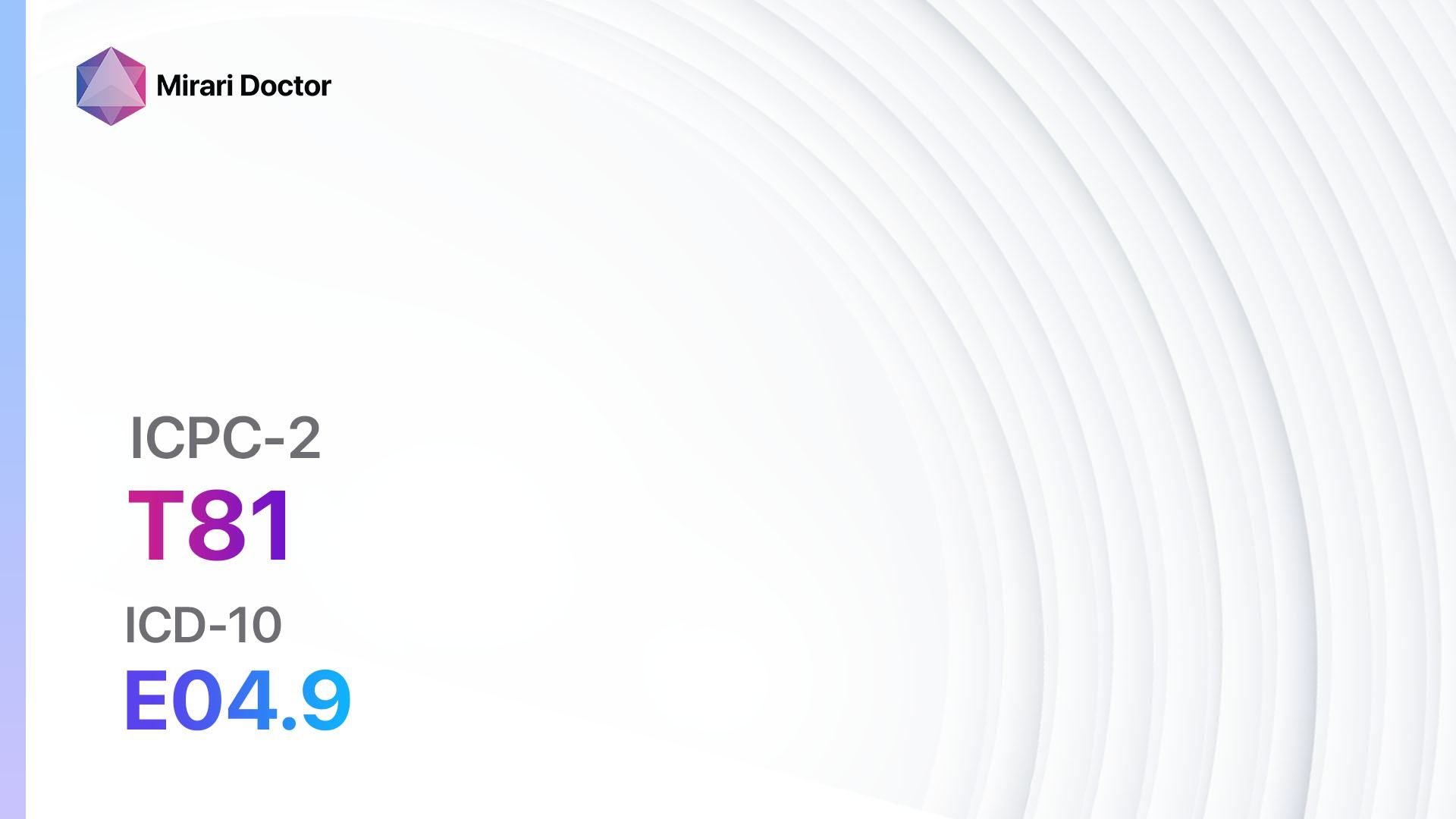
Introduction
Goitre is a condition characterized by the enlargement of the thyroid gland. It can be caused by various factors, including iodine deficiency, autoimmune diseases, and certain medications[1]. The aim of this guide is to provide a comprehensive overview of the symptoms, causes, diagnostic steps, possible interventions, and lifestyle interventions for goitre.
Codes
Symptoms
- Swelling or enlargement of the thyroid gland in the neck
- Visible swelling or lump in the neck
- Difficulty swallowing or breathing
- Hoarseness or voice changes
- Coughing or wheezing[2]
Causes
- Iodine deficiency: Lack of sufficient iodine in the diet can lead to goitre[3].
- Autoimmune diseases: Conditions such as Hashimoto’s thyroiditis and Graves’ disease can cause the thyroid gland to enlarge[4].
- Medications: Certain medications, such as lithium and amiodarone, can contribute to the development of goitre[5].
Diagnostic Steps
Medical History
- Gather information about the patient’s risk factors, such as family history of thyroid disorders or exposure to radiation.
- Inquire about symptoms related to goitre, such as difficulty swallowing or breathing, voice changes, or visible swelling in the neck.
- Assess the patient’s medical history for any underlying conditions that may contribute to the development of goitre, such as autoimmune diseases or iodine deficiency[6].
Physical Examination
- Perform a thorough examination of the neck to assess for any visible swelling or enlargement of the thyroid gland.
- Palpate the thyroid gland to determine its size, consistency, and tenderness.
- Evaluate the patient’s voice quality and assess for any hoarseness or voice changes[7].
Laboratory Tests
- Thyroid-stimulating hormone (TSH) test: Measures the levels of TSH in the blood to assess thyroid function.
- Thyroid hormone tests (T3 and T4): Measures the levels of thyroid hormones in the blood to evaluate thyroid function.
- Thyroid antibody tests: Helps to diagnose autoimmune thyroid diseases, such as Hashimoto’s thyroiditis or Graves’ disease.
- Iodine level test: Determines the levels of iodine in the body, which can help identify iodine deficiency as a cause of goitre[8].
Diagnostic Imaging
- Ultrasound: Uses sound waves to create images of the thyroid gland and assess its size, shape, and structure.
- Thyroid scan: Involves the injection of a radioactive substance that is taken up by the thyroid gland, allowing for visualization of its function and any abnormalities.
- CT scan or MRI: Provides detailed images of the thyroid gland and surrounding structures, helping to evaluate the extent of the goitre and identify any potential complications[9].
Other Tests
- Fine-needle aspiration biopsy: Involves the removal of a small sample of thyroid tissue for examination under a microscope, helping to determine if the goitre is cancerous or benign.
- Genetic testing: May be recommended in cases where a genetic cause of goitre is suspected, such as familial goitre[10].
Follow-up and Patient Education
- Schedule regular follow-up appointments to monitor the size and function of the thyroid gland.
- Educate the patient about the importance of maintaining a balanced diet, including sufficient iodine intake.
- Provide information about the potential complications of goitre and the importance of seeking medical attention if symptoms worsen or new symptoms develop[1].
Possible Interventions
Traditional Interventions
Medications:
Top 5 drugs for goitre:
- Levothyroxine:
- Cost: $10-$50/month.
- Contraindications: Hypersensitivity to levothyroxine, untreated adrenal insufficiency.
- Side effects: Headache, nervousness, increased appetite.
- Severe side effects: Chest pain, rapid or irregular heartbeat.
- Drug interactions: Antacids, iron supplements, calcium supplements.
- Warning: Regular monitoring of thyroid function is required.
- Methimazole:
- Cost: $10-$50/month.
- Contraindications: Hypersensitivity to methimazole, breastfeeding.
- Side effects: Nausea, vomiting, rash.
- Severe side effects: Severe allergic reactions, liver problems.
- Drug interactions: Warfarin, theophylline.
- Warning: Regular monitoring of thyroid function and liver function is required.
- Propylthiouracil:
- Cost: $10-$50/month.
- Contraindications: Hypersensitivity to propylthiouracil, breastfeeding.
- Side effects: Nausea, vomiting, rash.
- Severe side effects: Severe allergic reactions, liver problems.
- Drug interactions: Warfarin, theophylline.
- Warning: Regular monitoring of thyroid function and liver function is required.
- Radioactive iodine:
- Cost: $500-$1000.
- Contraindications: Pregnancy, breastfeeding.
- Side effects: Nausea, dry mouth, neck tenderness.
- Severe side effects: Radiation sickness, thyroid storm.
- Drug interactions: None.
- Warning: Requires isolation for a few days after treatment.
- Beta blockers (e.g., Propranolol):
- Cost: $10-$50/month.
- Contraindications: Asthma, heart failure.
- Side effects: Fatigue, dizziness, low blood pressure.
- Severe side effects: Slow heart rate, heart block.
- Drug interactions: Calcium channel blockers, insulin.
- Warning: Should not be abruptly stopped.
Alternative Drugs:
- Lugol’s solution: Contains iodine and can be used to treat iodine deficiency.
- Selenium supplements: May help reduce inflammation and improve thyroid function.
- Thyroid hormone replacement therapy: Used in cases of hypothyroidism caused by goitre.
Surgical Procedures:
- Thyroidectomy: Surgical removal of all or part of the thyroid gland. Cost: $10,000-$25,000.
- Radioactive iodine ablation: Involves the administration of a radioactive substance to destroy thyroid tissue. Cost: $500-$1000.
Alternative Interventions
- Acupuncture: May help reduce inflammation and improve thyroid function. Cost: $60-$120 per session.
- Herbal supplements: Certain herbs, such as ashwagandha and bugleweed, may have potential benefits for goitre. Cost: Varies depending on the specific supplement.
- Yoga and meditation: Can help reduce stress and promote overall well-being. Cost: Varies depending on the location and instructor.
- Dietary modifications: Including foods rich in iodine, such as seafood and iodized salt, can help address iodine deficiency. Cost: Varies depending on food choices.
Lifestyle Interventions
- Stress management: Engaging in stress-reducing activities, such as yoga or meditation, can help improve thyroid function. Cost: Varies depending on the chosen activities.
- Regular exercise: Physical activity can help improve overall health and promote thyroid function. Cost: Varies depending on the chosen activities.
- Dietary modifications: Consuming a balanced diet rich in fruits, vegetables, and lean proteins can support thyroid health. Cost: Varies depending on food choices.
- Avoiding goitrogenic foods: Limiting the intake of foods that can interfere with thyroid function, such as soy and cruciferous vegetables. Cost: Varies depending on food choices.
It is important to note that the cost ranges provided are approximate and may vary depending on the location and availability of the interventions.
Mirari Cold Plasma Alternative Intervention
Understanding Mirari Cold Plasma
- Safe and Non-Invasive Treatment:Mirari Cold Plasma is a safe and non-invasive treatment option for various skin conditions. It does not require incisions, minimizing the risk of scarring, bleeding, or tissue damage.
- Efficient Extraction of Foreign Bodies:Mirari Cold Plasma facilitates the removal of foreign bodies from the skin by degrading and dissociating organic matter, allowing easier access and extraction.
- Pain Reduction and Comfort:Mirari Cold Plasma has a local analgesic effect, providing pain relief during the treatment, making it more comfortable for the patient.
- Reduced Risk of Infection:Mirari Cold Plasma has antimicrobial properties, effectively killing bacteria and reducing the risk of infection.
- Accelerated Healing and Minimal Scarring: Mirari Cold Plasma stimulates wound healing and tissue regeneration, reducing healing time and minimizing the formation of scars.
Mirari Cold Plasma Prescription
Video instructions for using Mirari Cold Plasma Device – A01 Pain general/multiple sites (ICD-10:M79.6, R07.4, R10.4, R51)
Video instructions for using Mirari Cold Plasma Device – T81 Goitre (ICD-10:E04.9)
| Mild | Moderate | Severe |
| Mode setting: 1 (Infection) Location: 6 (Throat, Lymphatic & Thyroid) Morning: 15 minutes, Evening: 15 minutes | Mode setting: 1 (Infection) Location: 6 (Throat, Lymphatic & Thyroid) Morning: 30 minutes, Lunch: 30 minutes, Evening: 30 minutes | Mode setting: 1 (Infection) Location: 6 (Throat, Lymphatic & Thyroid) Morning: 30 minutes, Lunch: 30 minutes, Evening: 30 minutes |
| Mode setting: 2 (Wound Healing) Location: 6 (Throat, Lymphatic & Thyroid) Morning: 15 minutes, Evening: 15 minutes | Mode setting: 2 (Wound Healing) Location: 6 (Throat, Lymphatic & Thyroid) Morning: 30 minutes, Lunch: 30 minutes, Evening: 30 minutes | Mode setting: 2 (Wound Healing) Location: 6 (Throat, Lymphatic & Thyroid) Morning: 30 minutes, Lunch: 30 minutes, Evening: 30 minutes |
| Mode setting: 3 (Antiviral Therapy) Location: 6 (Throat, Lymphatic & Thyroid) Morning: 15 minutes, Evening: 15 minutes | Mode setting: 3 (Antiviral Therapy) Location: 6 (Throat, Lymphatic & Thyroid) Morning: 30 minutes, Lunch: 30 minutes, Evening: 30 minutes | Mode setting: 3 (Antiviral Therapy) Location: 6 (Throat, Lymphatic & Thyroid) Morning: 30 minutes, Lunch: 30 minutes, Evening: 30 minutes |
| Mode setting:7 (Immunotherapy) Location:1 (Sacrum) Morning:15 minutes, Evening:15minutes | Mode setting:7 (Immunotherapy) Location:1 (Sacrum) Morning:30 minutes, Lunch:30 minutes, Evening:30 minutes | Mode setting:7 (Immunotherapy) Location:1 (Sacrum) Morning:30 minutes, Lunch:30 minutes, Evening:30 minutes |
| Total Morning:60minutesapprox.$10USD, Evening:60minutesapprox.$10USD | Total Morning:120minutesapprox.$20USD, Lunch:120minutesapprox. $20 USD, Evening:120minutesapprox. $20 USD, | Total Morning:120minutesapprox.$20USD, Lunch:120minutesapprox. $20 USD, Evening:120minutesapprox. $20 USD, |
| Usualtreatmentfor7-60daysapprox.$140USD–$1200USD | Usualtreatmentfor6-8weeksapprox.$2,520USD–$3,360USD | Usualtreatmentfor3-6monthsapprox.$5,400USD–$10,800USD |
 |
|
Use the Mirari Cold Plasma device to treat Goitre effectively.
WARNING: MIRARI COLD PLASMA IS DESIGNED FOR THE HUMAN BODY WITHOUT ANY ARTIFICIAL OR THIRD PARTY PRODUCTS. USE OF OTHER PRODUCTS IN COMBINATION WITH MIRARI COLD PLASMA MAY CAUSE UNPREDICTABLE EFFECTS, HARM OR INJURY. PLEASE CONSULT A MEDICAL PROFESSIONAL BEFORE COMBINING ANY OTHER PRODUCTS WITH USE OF MIRARI.
Step 1: Cleanse the Skin
- Start by cleaning the affected area of the skin with a gentle cleanser or mild soap and water. Gently pat the area dry with a clean towel.
Step 2: Prepare the Mirari Cold Plasma device
- Ensure that the Mirari Cold Plasma device is fully charged or has fresh batteries as per the manufacturer’s instructions. Make sure the device is clean and in good working condition.
- Switch on the Mirari device using the power button or by following the specific instructions provided with the device.
- Some Mirari devices may have adjustable settings for intensity or treatment duration. Follow the manufacturer’s instructions to select the appropriate settings based on your needs and the recommended guidelines.
Step 3: Apply the Device
- Place the Mirari device in direct contact with the affected area of the skin. Gently glide or hold the device over the skin surface, ensuring even coverage of the area experiencing.
- Slowly move the Mirari device in a circular motion or follow a specific pattern as indicated in the user manual. This helps ensure thorough treatment coverage.
Step 4: Monitor and Assess:
- Keep track of your progress and evaluate the effectiveness of the Mirari device in managing your Goitre. If you have any concerns or notice any adverse reactions, consult with your health care professional.
Note
This guide is for informational purposes only and should not replace the advice of a medical professional. Always consult with your healthcare provider or a qualified medical professional for personal advice, diagnosis, or treatment. Do not solely rely on the information presented here for decisions about your health. Use of this information is at your own risk. The authors of this guide, nor any associated entities or platforms, are not responsible for any potential adverse effects or outcomes based on the content.
Mirari Cold Plasma System Disclaimer
- Purpose: The Mirari Cold Plasma System is a Class 2 medical device designed for use by trained healthcare professionals. It is registered for use in Thailand and Vietnam. It is not intended for use outside of these locations.
- Informational Use: The content and information provided with the device are for educational and informational purposes only. They are not a substitute for professional medical advice or care.
- Variable Outcomes: While the device is approved for specific uses, individual outcomes can differ. We do not assert or guarantee specific medical outcomes.
- Consultation: Prior to utilizing the device or making decisions based on its content, it is essential to consult with a Certified Mirari Tele-Therapist and your medical healthcare provider regarding specific protocols.
- Liability: By using this device, users are acknowledging and accepting all potential risks. Neither the manufacturer nor the distributor will be held accountable for any adverse reactions, injuries, or damages stemming from its use.
- Geographical Availability: This device has received approval for designated purposes by the Thai and Vietnam FDA. As of now, outside of Thailand and Vietnam, the Mirari Cold Plasma System is not available for purchase or use.
References
- Mayo Clinic. (2022). Goiter – Symptoms & causes. Retrieved from//www.mayoclinic.org/diseases-conditions/goiter/symptoms-causes/syc-20351829
- NHS. (2022). Goitre. Retrieved from//www.nhs.uk/conditions/goitre/
- Medical News Today. (2021). Goiter: Causes, treatment, types, and symptoms. Retrieved from//www.medicalnewstoday.com/articles/167559
- Cleveland Clinic. (2022). Goiter: What It Is, Causes, Symptoms, Diagnosis & Treatment. Retrieved from//my.clevelandclinic.org/health/diseases/12625-goiter
- Healthline. (2021). Goiter: Causes, Types, and Treatment. Retrieved from//www.healthline.com/health/goiter-simple
- RACGP. (2012). Goitre – Causes, investigation and management. Retrieved from//www.racgp.org.au/afp/2012/august/goitre
- Johns Hopkins Medicine. (n.d.). Goiter. Retrieved from//www.hopkinsmedicine.org/health/conditions-and-diseases/goiter
- Mayo Clinic. (2021). Goiter – Diagnosis & treatment. Retrieved from//www.mayoclinic.org/diseases-conditions/goiter/diagnosis-treatment/drc-20351834
- WebMD. (2021). What Is a Goiter? What Causes Goiters? Retrieved from//www.webmd.com/women/understanding-goiter-basics
- Penn Medicine. (n.d.). Goiter – Symptoms and Causes. Retrieved from//www.pennmedicine.org/for-patients-and-visitors/patient-information/conditions-treated-a-to-z/goiter
Related articles
Made in USA


